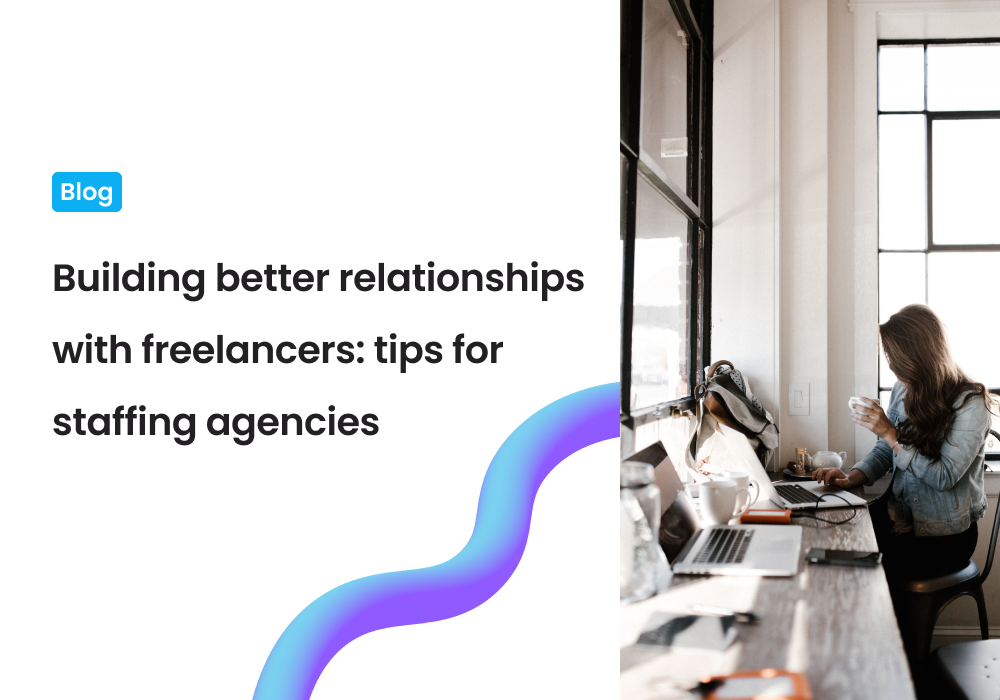Finding a freelancer that's a good fit for a particular project can make all the difference between that project succeeding and failing.
But, of course, in the case of staffing agencies, you have the added pressure of said freelancer representing your agency too.
So, with so much riding on the skills and aptitude of your freelance talent pool, when you find top-quality talent, you want to hang onto them!
Perhaps unsurprisingly, fostering healthy working relationships with freelancers is the best way to ensure they'll want to collaborate with you time and again.
So, here we're revealing a few tips for staffing agencies looking to build better relationships with their freelancers.
There's lots to chat about, so let's dive straight in!
Background
But first, let’s rewind a little with some background information:
The demand for freelance talent has never been higher, with a surge of employers turning to freelancers in response to the worldwide skills shortage. Interestingly, as many as 87% of employers expect this situation to remain for several years. More specifically, tech, data, sales, marketing, manufacturing, production, customer-facing, and front-of-office freelance roles are in exceptionally high demand.
The bottom line: Against this backdrop, staffing agencies must work fast and hard to find and retain freelancers that can help their clients plug their gaping skills gaps.
Regarding freelancer retention, the best way to increase the likelihood of a long-lasting working relationship is to ensure a good experience with your agency every step of the way.
Let's look at this in more detail:
Find the Right Freelancer for the Job
To put your best foot forward, place freelancers with clients requiring their skillset.
The above may sound obvious, but for freelancers, time is often literally money. So wasting their precious time by assigning projects they don't have the expertise to execute is a surefire way to sour the working relationship before it even begins.
So, first, speak to your client and request a detailed outline of their requirements.
This should include the following:
-
Any specific skills/experience/education needed
-
Deadlines/milestones
-
Their expectations
-
The length of time the job will take
-
The client’s budget
Then, with this info in hand, turn your attention to your freelance talent pool/recruitment efforts. You'll need to cross-reference the above requirements with the freelancers:
-
Expertise/credentials/portfolio/experience, etc.
-
Their availability
-
The role(s) they're seeking
-
Their rates
Then, when you have a potential match, contact the freelancer to invite them to work on the project. The above process goes a long way to increasing the likelihood of the freelancer accepting the job offer and your client being satisfied with the quality of work produced - win-win!
This prep work might sound arduous, but it will save time in the long run. One way to speed things up is to use freelance management software like Bubty that enables you to filter and search your freelancer talent pool by availability, location, skills, price, and the language(s) they speak. You can then easily invite relevant freelancers to the project.
Good Onboarding
A Gallup poll found that only 12% of respondents strongly agreed the company they worked for did a good job onboarding.
Needless to say, if you're working with a new freelancer, you're still creating a first impression during the onboarding phase. So, to cement your agency's relationship with the freelancer, you'll want to handle this well.
Your freelancer may have already completed your staffing agency’s onboarding and compliance process when they signed up with you. Still, your client might have their own regulations. If so, you'll need to forward all the necessary documents/information to the freelancer as soon as possible. For example, they might have to electronically sign NDAs, confidentiality agreements, non-competes, etc.
Again, this is where freelance management software is handy. A decent platform will automate this process to ensure nothing is missed that could delay the project's start. A transparent and efficient onboarding system also minimizes confusion for the freelancer and the time you need to spend chasing up documentation, so it's in everyone's interests to get this right!
Discuss Timelines and How You’ll Communicate
Establish timelines and communication methods from the start. Remember, freelancers often juggle several projects across multiple clients and typically don’t work a traditional 9-5 week. In fact, one study found that 51% said they wouldn’t return to that model, no matter how much money they were offered.
So with that in mind, it's all the more important to be clear about how and when you communicate with freelancers - especially if your working hours don't completely align.
First, establish a regular line and point of contact. For example, a weekly check-in via live chat to see how they’re doing in their new role. This is great for nurturing the relationship and ensuring the freelancer is happy and working on schedule. However, it’s also important not to be too prescriptive, and to be open to freelancers contacting you outside of a weekly check-in, should they need it.
You'll also want to be clear about the client’s expectations and deadlines from the get-go. It’s your role to act as the middle person between the client and freelancer, so clearly convey any project details/instructions/information to the freelancer that the client has passed onto you.
You can centralize communications with freelancers using freelance management software like Bubty. This has a chat and connect feature where you can quickly connect and chat with freelancers within Bubty’s project pages. You can see which projects freelancers are working on and check in on how they are doing. Similarly, this chat feature can be used during the onboarding and compliance processes.
Build Trust and Rapport
As hinted at throughout this blog post, building trust and rapport with freelancers is critical to nurturing more fruitful working relationships. If you’re unsure where to begin, here are a few pointers:
-
Pass on feedback from clients to the freelancer, including praise, with 96% of freelancers saying they prefer to work with clients who show appreciation and value their work.
-
Demonstrate awareness and understanding of the pressures freelancers face, such as changing deadlines, uncertain income levels, meeting unrealistic demands, being paid on time, etc. For example, you could acknowledge that a piece of work is challenging and address any pressures your freelancer encounters during your regular catch-up calls. You could also publish a blog post on your agency’s website acknowledging the typical strains freelancers face. All this goes a long way to fostering a sense of openness and demonstrating empathy which is crucial for building rapport.
-
Understand that freelancers appreciate flexibility in their workload and work schedule, with 30% wanting to choose their own hours and 27% wanting to work part-time. So, with that in mind, try, where possible, to match freelancers to clients where a mutually beneficial working arrangement can be agreed upon.
-
Remember, 61% of freelancers miss the sense of community that comes with an office job and may feel like they’re working in a vacuum. So although your freelancers don’t work directly with you, they represent your agency, so invite them along to company events (where appropriate) and share company news. This goes a long way to making freelancers feel included and valued in your agency.
Pay Freelancers on Time
You can follow all the above steps to the letter. Still, if you don’t pay your freelancers on time or don’t pay them at all, you risk souring the relationship beyond repair. For example, theIndependent Economy Councilreported in 2022 that 59% of US freelancers are owed $50,000 or more, with 72% saying they have outstanding invoices that have gone unpaid. Elsewhere, in the UK, 55% of freelancers, at some point or another, haven’t been paid for their work.
A straightforward way to ensure you pay freelancers on time is to use freelance management software that integrates with the accounting tools you already use - for instance, Excel, QuickBooks, or Xero. With such a system, you can approve and manage all uploaded invoices and keep track of costs from the convenience of one place. On the freelancer side of things, a top-notch freelance management platform should also enable them to easily upload or generate their invoices onto your FMS and track their invoices to see if a payment is pending or paid.
Can Bubty Help You Build Better Relationships With Freelancers?
Bubty is a freelance management software offering a range of features that streamline freelancer payments, onboarding, compliance, communication, and availability.
As we’ve hinted throughout this blog post, it’s a reliable system that can be used to bolster not only your staffing agency’s efficiency but also the relationships you have with freelancers.




